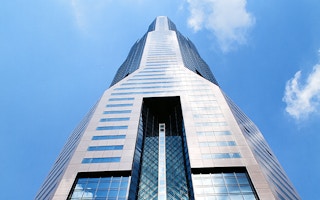Singapore property giant City Developments Limited (CDL) on Thursday issued an S$100 million green bond, becoming first local company in the city-state to do so.
Green bonds raise money that is specially allocated for funding projects that have positive environmental and climate benefits. CDL’s bond was issued by its subsidiary CDL Properties, and will be used to repay a S$100 million loan that CDL Properties borrowed from CDL.
CDL Properties used the loan to make sustainability upgrades to CDL’s headquarters, a building called Republic Plaza. Investors in the bond comprise mainly financial institutions and fund managers.
Located in downtown Singapore, Republic Plaza was completed in 1996 and is one of Singapore’s tallest skyscrapers. It has undergone retrofits including an upgraded chiller plant, energy efficient lights, and motion sensors to reduce energy wastage.
These upgrades in 2012 helped Republic Plaza earn the highest possible rating in Singapore’s national green building certification scheme, the platinum award. The energy and water efficiency savings from the retrofits have also helped the building save as much electricity as the consumption of 1,200 3-bedroom units; and about four Olympic-sized swimming pools worth of water every year.
This translates to about S$1.2 million in savings every year.
Sherman Kwek, deputy chief executive officer, CDL, said in a statement that “green finance offers us an alternative financing stream”.
“CDL’s inaugural green bond, also the first by a Singapore company, links our sustainability initiatives with the capital markets,” added Kwek. He also shared that the bond enables the company to tap on investors that are supportive of CDL’s sustainability commitments.
The company’s announcement comes at a time when global interest in green bonds is rising. Credit rating and research firm Moody’s, for instance, expects the global green bonds market to grow from US$93.4 billion in 2016, to as much as US$206 billion this year.
Green bonds reached Asia in about 2013, according to responsible investment non-profit Climate Bonds Intiative (CBI). Countries such as China, Japan, India, and South Korea have dominated the region’s green bonds market, accounting for almost US$300 billion of climate-aligned bonds in 2016.
Hong Kong and Thailand add a further US$4.7 billion to the region’s green bonds market. Hong Kong-based real estate firm Link Reit, for example, issued a US$500 million green bond last year.
In comparison, CBI estimates North America’s green bond market to be worth US$138 billion, while Western Europe has issued US$195 billion in green bonds to date.
Singapore’s inaugural green bond may be smaller and a late entrant to the global green bonds market, but CDL said its effort paves the way for other Singapore firms in the city state to tap into this fast growing market and finance their own sustainability initiatives.
“CDL’s green bond issuance also complements the Singapore government’s target of greening at least 80 per cent of the country’s building stock by 2030,” added Kwek. “It is clear that for the next 13 years, real estate companies have a large role to play in mitigating climate change and contributing towards Singapore’s greening and emissions reduction goals.”
Demand for environmentally sound investments has risen since the Paris Agreement on climate change was signed in December 2015, and came into force last November. The agreement has prompted countries, including Singapore, to step up their search for ways to reduce their greenhouse gas emissions so that a global temperature rise is limited to 2 degrees Celsius above pre-industrial levels.

















